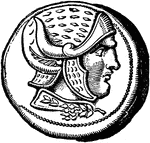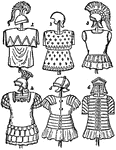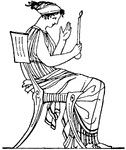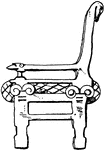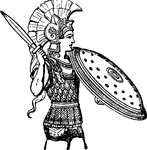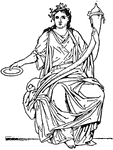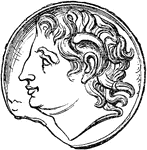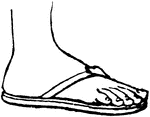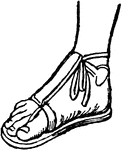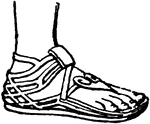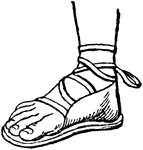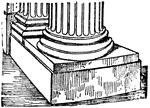
Scythians on a Greek Vase
Two Scythians tying a rope. This is one of the few existing representations of the ancient Scythians.…
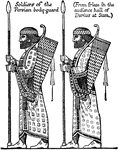
Persian Soldiers
Soldiers of the Persian bodyguard. From frieze in the audience hall of Darius at Susa.
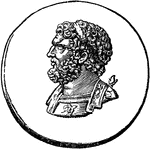
Philip of Macedon
Philip became king of Macedonia in 359 B.C. He was viewed as he best educated man of his time.
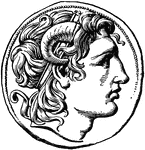
Coin of Alexander the Great
Alexander the Great's head on a silver coin of Lysimachus in 321-281 B.C.

Ptolemy in Profile
He was a mathematician, geographer, astronomer, and astrologer. "The name of a line Graeco-Egyptain…

Atalanta's Race
The race with Hippomenes' for Atalanta's hand in marriage. He won by distracting her with beautiful…
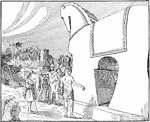
Trojan Horse
The Trojan Horse given to the Trojans from the Greeks as a gift but was actually war strategy, the horse…

Niobe
In Greek mythology, Niobe was a princess who had twelve children. She boasted of them to Leto who only…
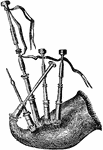
Bagpipe
The bagpipe is a wind instrument used among the ancient Greeks but is known as a Scottish and Irish…

Greek Priest's Arm-Chair
The Greek Priest's chair was made out of marble and was found by the door of the temple of Themis, Athens.
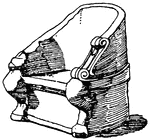
Greek Judge's Arm-Chair
The Greek judge's chair was made of marble and was found on the site of the Prytaneum, Athens.

Greek Bedstead
The Greek bedstead had a vase painting and served partly as bed, and partly as couch.

Fates
The three fates of Greek Mythology were three sisters who spun the thread of life named Clotho, Lachesis,…
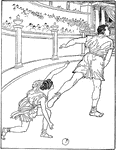
Atalanta's Race
Atalanta being distracted to pick up one of three golden apples dropped by Melanion, her suitor during…

Portion of Rosetta Stone
"In the Nile valley there had been found a few ancient inscriptions, carved upon stone in unknown characters,…
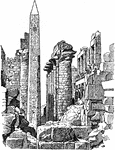
Temple of the Sun at Karnak
"A considerable part of the land -- perhaps one third -- belonged to temples, in order that the temple…
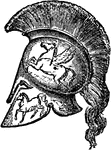
Helmet
The oldest use of helmets was by Ancient Greek soldiers, who wore thick leather or bronze helmets to…

Cathedral Spires in the Garden of the Gods, Colorado
The outstanding geologic features of the park are the ancient sedimentary beds of red and white sandstones,…
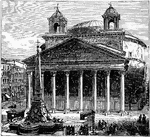
The Pantheon at Rome
The Pantheon is a building in Rome which was originally built as a temple to all the gods of Ancient…
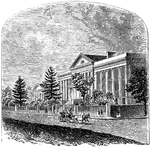
Marine Hospital
The United States Marine Hospital is a historic Greek Revival hospital building in Mobile, Alabama.…
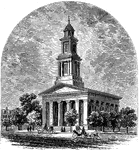
Christ Church
Christ Church Cathedral was established in 1823 as the first Episcopal congregation in Mobile, Alabama…
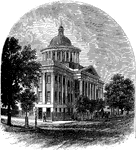
Barton Academy
Barton Academy is a historic Greek Revival school building located in Mobile, Alabama. IT was under…
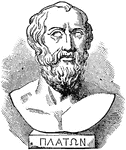
Plato
Plato was a Classical Greek philosopher, who, together with his mentor, Socrates, and his student, Aristotle,…

Aristotle
Aristotle was a Greek philosopher, a student of Plato and teacher of Alexander the Great. He wrote on…
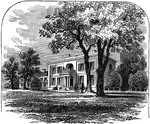
Kalorama
The residence was rechristened "Kalorama", Greek for "beautiful view", by its new owner, American author…

Stick Insect
The Phasmatodea (sometimes called Plasmodia) are an order of insects, whose members are variously known…

Parthenon
The Parthenon is a temple of the Greek goddess Athena, built in the 5th century BC on the Athenian Acropolis.…
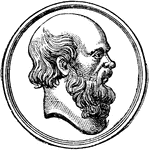
Socrates
An illustration of Socrates, a Classical Greek philosopher. Credited as one of the founders of Western…

Plato
An illustration of Plato, a Classical Greek philosopher, who, together with his mentor, Socrates, and…
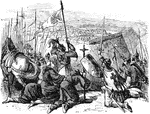
Crusaders
An illustration of crusaders before Jerusalem. The Crusades were a series of military campaigns of a…
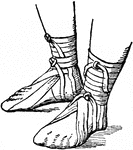
Roman Sandal
A sandal worn in Ancient Rome. This sandal is different from Greek sandals because it has a vamp, or…

Sarcophagus
"Sarcophagus from the Street of Tombs at Assos in the Troad, excavated by the Archaeological Institute…
Cocoanut Palm Spadix
An illustration of a cocoanut palm's spadix. In botany, a spadix (pl. spadices) is a type of spike:…
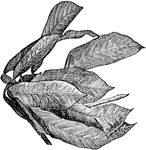
Croton
Croton is an extensive plant genus of the family Euphorbiaceae established by Carolus Linnaeus in 1737.…
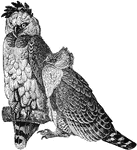
American Harpy Eagle
The American Harpy Eagle (Harpia harpyja) is a neotropical eagle, often simply called the Harpy Eagle.…

Ancient Egyptian Sarcophagus
A sarcophagus is a funeral receptacle for a corpse, most commonly carved or cut from stone. The word…
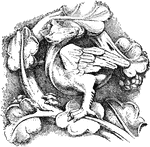
Foliate Sculpture
Foliate Sculpture of the 13th Century. "Decorative sculpture conventionalized more or less from foliage,…
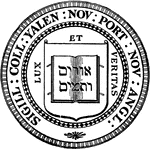
Seal of Yale University
Serious American students of theology and divinity, particularly in New England, regarded Hebrew as…

Osiris Pier, Medinet Habu
Piers and columns sustained the roofs for chambers that were too wide for single lintels, and produced,…
